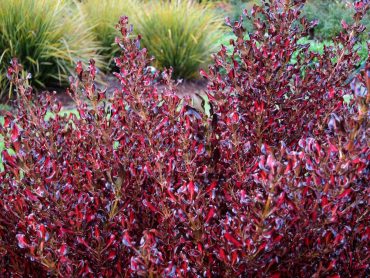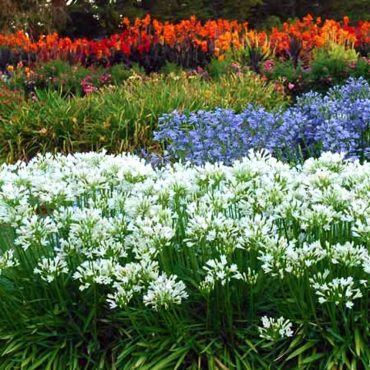
Edging plants can work miracles — from fixing messy beds and directing garden traffic to serving as garden railings. Here’s are three ways garden-edging plants can work miracles.
Instant Fix for Messy Beds
Every garden reaches the stage where it’s full of plants but suddenly looks a mess. Home-gardener or landscaped-designed garden beds all go through this stage because it’s all about the plants reaching an age where they loosen up a little.
The result is a landscape that has lost its planned structure and balance. There are lots of complex ways to pull everything back onto line, but the easiest of all is to add in a border.
That’s right. Plant a row of something lovely along the front of the bed and everything else — no matter how unruly — will look fantastic again.
Of course, you need the right type of plant. Something that’s not too tall, something that can look after itself and if it has flowers, that’s even better. Something like Storm agapanthus. If you plant them closely, they’ll quickly form an unbroken edging of strappy foliage. Then in late spring, you’ll have dancing heads of blue flowers for weeks and weeks.
There is a white version available as well, but whatever the color, a repetitive planting is a great addition to any messy garden simply because it tends to tie things together.

Directing Garden Traffic
Sometimes the best-laid paths just don’t seem to be able to attract the foot traffic. Maybe there’s some confusion over how to get to your front door, or perhaps people just like to take shortcuts. The result can be a dirt goat-track running through your garden or lawn where you’d really rather a bed full of untrampled flowers or a lush green sward.
The solution is an easy one. Plant a barrier-row of plants and watch all but the most determined tramplers be redirected back onto the paved path.
Again, the success of this move is in the plant selection. You need something that people notice simply because once noticed, it’s hard to ignore and step over. You also need something that has the capacity to form a barrier that’s wide enough and high enough to make things awkward.
With their low spreading habit, Flower Carpet roses are an ideal option. And even when they’re not in bloom, their glossy green foliage adds a bit of interest.
Greenery as Garden Railings
Gardens with different levels can start to look a bit fussy if you build railings wherever there’s a break between each variation in height. The classic scenario is the paved patio or deck that sits at knee height above the garden below. A railing here would be an eyesore, and an overkill in terms of safety (no one’s likely to hurtle to their death falling 16 inches).
The solution is a barrier of something living and green — a little reminder not to stray too close to the edge.
And by green, we don’t necessarily mean green because one of the best candidates for the role of living garden railing is the Festival cordyline. It comes in three gorgeous over-the-top colors — raspberry, burgundy and lime — and it grows into a 3-foot-high cascade of strappy foliage from a basal clump that’s thick enough to define the edge and soft enough to catch anyone silly enough to step backwards without thinking.























